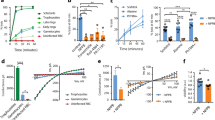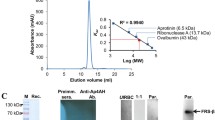Abstract
Plasmodium falciparum, the most important etiological agent of human malaria, is endowed with a highly complex cell cycle that is essential for its successful replication within the host. A number of evidence suggest that changes in parasite Ca2+ levels occur during the intracellular cycle of the parasites and play a role in modulating its functions within the RBC. However, the molecular identification of Plasmodium receptors linked with calcium signalling and the causal relationship between Ca2+ increases and parasite functions are still largely mysterious. We here describe that increases in P. falciparum Ca2+ levels, induced by extracellular ATP, modulate parasite invasion. In particular, we show that addition of ATP leads to an increase of cytosolic Ca2+ in trophozoites and segmented schizonts. Addition of the compounds KN62 and Ip5I on parasites blocked the ATP-induced rise in [Ca2+]c. Besides, the compounds or hydrolysis of ATP with apyrase added in culture drastically reduce RBC infection by parasites, suggesting strongly a role of extracellular ATP during RBC invasion. The use of purinoceptor antagonists Ip5I and KN62 in this study suggests the presence of putative purinoceptor in P. falciparum. In conclusion, we have demonstrated that increases in [Ca2+]c in the malarial parasite P. falciparum by ATP leads to the modulation of its invasion of red blood cells.




Similar content being viewed by others
Abbreviations
- THG:
-
Thapsigargin
- [Ca2+]c :
-
Calcium cytosolic concentration
- RBC:
-
Red blood cell
- SmATPDase:
-
S. mansoni ATP-diphosphohydrolase
References
Maier AG, Cooke BM, Cowman AF, Tilley L (2009) Malaria parasite proteins that remodel the host erythrocyte. Nat Rev Microbiol 7:341–354
Haldar K, Hiller NL, van Ooij C, Bhattacharjee S (2005) Plasmodium parasite proteins and the infected erythrocyte. Trends Parasitol 21:402–403
Ward P, Equinet L, Packer J, Doerig C (2004) Protein kinases of the human malaria parasite Plasmodium falciparum: the kinome of a divergent eukaryote. BMC Genomics 5:79
Doerig C (2004) Protein kinases as targets for anti-parasitic chemotherapy. Biochim Biophys Acta 1697:155–168
Beraldo FH, Garcia CRS (2005) Products of tryptophan catabolism induce Ca2+ release and modulate the cell cycle of Plasmodium falciparum malaria parasites. J Pineal Res 39:224–230
Hotta CT, Gazarini ML, Beraldo FH, Varotti FP, Lopes C, Markus RP, Pozzan T, Garcia CRS (2000) Calcium-dependent modulation by melatonin of the circadian rhythm in malarial parasites. Nat Cell Biol 2:466–468
Hotta CT, Markus RP, Garcia CRS (2003) Melatonin and N-acetyl-serotonin cross the red blood cell membrane and evoke calcium mobilization in malarial parasites. Braz J Med Biol Res 36:1583–1587
Akkaya C, Shumilina E, Bobballa D, Brand VB, Mahmud H, Lang F, Huber SM (2009) The Plasmodium falciparum-induced anion channel of human erythrocytes is an ATP-release pathway. Pflügers Arch Eur J Physiol 457:1035–1047
Burnstock G, Verkhratsky A (2009) Evolutionary origins of the purinergic signalling system. Acta Physiol 195:415–447
Burnstock G (2007) Purine and pyrimidine receptors. Cell Mol Life Sci 64:1471–1483
van der Weyden L, Adams DJ, Luttrell BM, Conigrave AD, Morris MB (2000) Pharmacological characterisation of the P2Y11 receptor in stably transfected haematological cell lines. Mol Cell Biochem 213:75–81
Communi D, Govaerts C, Parmentier M, Boeynaems JM (1997) Cloning of a human purinergic P2Y receptor coupled to phospholipase C and adenylyl cyclase. J Biol Chem 272:31969–31973
Communi D, Gonzalez NS, Detheux M, Brezillon S, Lannoy V, Parmentier M, Boeynaems JM (2001) Identification of a novel human ADP receptor coupled to G(i). J Biol Chem 276:41479–41485
Hollopeter G, Jantzen HM, Vincent D, Li G, England L, Ramakrishnan V, Yang RB, Nurden P, Nurden A, Julius D et al (2001) Identification of the platelet ADP receptor targeted by antithrombotic drugs. Nature 409:202–207
Zhang FL, Luo L, Gustafson E, Palmer K, Qiao X, Fan X, Yang S, Laz TM, Bayne M, Monsma F Jr (2002) P2Y(13): identification and characterization of a novel Galphai-coupled ADP receptor from human and mouse. J Pharmacol Exp Ther 301:705–713
Trager W, Jensen JB (1976) Human malaria parasites in continuous culture. Science (New York, NY) 193:673–675
Lambros C, Vanderberg JP (1979) Synchronization of Plasmodium falciparum erythrocytic stages in culture. J Parasitol 65:418–420
Di Virgilio F, Steinberg TH, Silverstein SC (1990) Inhibition of Fura-2 sequestration and secretion with organic anion transport blockers. Cell Calcium 11:57–62
Varotti FP, Beraldo FH, Gazarini ML, Garcia CR (2003) Plasmodium falciparum malaria parasites display a THG-sensitive Ca2+ pool. Cell Calcium 33:137–144
Billker O, Dechamps S, Tewari R, Wenig G, Franke-Fayard B, Brinkmann V (2004) Calcium and a calcium-dependent protein kinase regulate gamete formation and mosquito transmission in a malaria parasite. Cell 117:503–514
Biagini GA, Bray PG, Spiller DG, White MR, Ward SA (2003) The digestive food vacuole of the malaria parasite is a dynamic intracellular Ca2+ store. J Biol Chem 278:27910–27915
Garcia CRS, Dluzewski AR, Catalani LH, Burting R, Hoyland J, Mason WT (1996) Calcium homeostasis in intraerythrocytic malaria parasites. Eur J Cell Biol 71:409–413
Wildman SS, King BF (2008) P2X receptors: epithelial ion channels and regulators of salt and water transport. Nephron Physiol 108:p60–p67
Bavan S, Straub VA, Blaxter ML, Ennion SJ (2009) A P2X receptor from the tardigrade species Hypsibius dujardini with fast kinetics and sensitivity to zinc and copper. BMC Evol Biol 9:17
North RA, Surprenant A (2000) Pharmacology of cloned P2X receptors. Annu Rev Pharmacol Toxicol 40:563–580
Moreno SN, Docampo R (2003) Calcium regulation in protozoan parasites. Curr Opin Microbiol 6:359–364
Vaid A, Sharma P (2006) PfPKB, a protein kinase B-like enzyme from Plasmodium falciparum: II. Identification of calcium/calmodulin as its upstream activator and dissection of a novel signaling pathway. J Biol Chem 281:27126–27133
Gazarini ML, Thomas AP, Pozzan T, Garcia CRS (2003) Calcium signaling in a low calcium environment: how the intracellular malaria parasite solves the problem. J Cell Biol 161:103–110
Garcia CRS, de Azevedo MF, Wunderlich G, Budu A, Young JA, Bannister L (2008) Plasmodium in the postgenomic era: new insights into the molecular cell biology of malaria parasites. Int Rev Cell Mol Biol 266(266):85−+
Wasserman M, Chaparro J (1996) Intraerythrocytic calcium chelators inhibit the invasion of Plasmodium falciparum. Parasitol Res 82:102–107
McCallum-Deighton N, Holder AA (1992) The role of calcium in the invasion of human erythrocytes by Plasmodium falciparum. Mol Biochem Parasitol 50:317–323
LaGreca N, Hibbs AR, Riffkin C, Foley M, Tilley L (1997) Identification of an endoplasmic reticulum-resident calcium-binding protein with multiple EF-hand motifs in asexual stages of Plasmodium falciparum. Mol Biochem Parasitol 89:283–293
Matsumoto Y, Perry G, Scheibel LW, Aikawa M (1987) Role of calmodulin in Plasmodium falciparum: implications for erythrocyte invasion by the merozoite. Eur J Cell Biol 45:36–43
Scheibel LW, Colombani PM, Hess AD, Aikawa M, Atkinson CT, Milhous WK (1987) Calcium and calmodulin antagonists inhibit human malaria parasites (Plasmodium falciparum): implications for drug design. Proc Natl Acad Sci USA 84:7310–7314
Billker O, Lourido S, Sibley LD (2009) Calcium-dependent signaling and kinases in apicomplexan parasites. Cell Host Microbe 5:612–622
Beraldo FH, Mikoshiba K, Garcia CRS (2007) Human malarial parasite, Plasmodium falciparum, displays capacitative calcium entry: 2-aminoethyl diphenylborinate blocks the signal transduction pathway of melatonin action on the P. falciparum cell cycle. J Pineal Res 43:360–364
Budu A, Peres R, Bueno VB, Catalani LH, Garcia CR (2007) N1-acetyl-N2-formyl-5-methoxykynuramine modulates the cell cycle of malaria parasites. J Pineal Res 42:261–266
Garcia CR, Markus RP, Madeira L (2001) Tertian and quartan fevers: temporal regulation in malarial infection. J Biol Rhythms 16:436–443
Beraldo FH, Almeida FM, da Silva AM, Garcia CR (2005) Cyclic AMP and calcium interplay as second messengers in melatonin-dependent regulation of Plasmodium falciparum cell cycle. J Cell Biol 170:551–557
Berridge MJ, Bootman MD, Roderick HL (2003) Calcium signalling: dynamics, homeostasis and remodelling. Nat Rev Mol Cell Biol 4:517–529
Farias SL, Gazarini ML, Melo RL, Hirata IY, Juliano MA, Juliano L, Garcia CR (2005) Cysteine-protease activity elicited by Ca2+ stimulus in Plasmodium. Mol Biochem Parasitol 141:71–79
Wasserman M (1990) The role of calcium ions in the invasion of Plasmodium falciparum. Blood Cells 16:450–451
Vaid A, Thomas DC, Sharma P (2008) Role of Ca2+/calmodulin-PfPKB signaling pathway in erythrocyte invasion by Plasmodium falciparum. J Biol Chem 283:5589–5597
Ayi K, Liles WC, Gros P, & Kain KC (2009) Adenosine Triphosphate Depletion of Erythrocytes Simulates the Phenotype Associated with Pyruvate Kinase Deficiency and Confers Protection against Plasmodium falciparum In Vitro. Journal of Infectious Diseases 200:1289–1299.
Tanneur V, Duranton C, Brand VB, Sandu CD, Akkaya C, Kasinathan RS, Gachet C, Sluyter R, Barden JA, Wiley JS, et al. (2006) Purinoceptors are involved in the induction of an osmolyte permeability in malaria-infected and oxidized human erythrocytes. FASEB J 20:133–135.
Gati WP, Lin AN, Wang TI, Young JD, & Paterson AR (1990) Parasite-induced processes for adenosine permeation in mouse erythrocytes infected with the malarial parasite Plasmodium yoelii. Biochem J 272:277-280.
Nagamune K, Sibley LD (2006) Comparative genomic and phylogenetic analyses of calcium ATPases and calcium-regulated proteins in the apicomplexa. Mol Biol Evol 23:1613–1627
Acknowledgements
We are grateful to Dr. Sergio Verjovski de Almeida (Chemistry Institute, São Paulo University) for kindly providing the recombinant apyrase from S. mansoni. This work was supported by grants from Brazilian Agencies FAPESP, CNPq (to C.R.S.G)-INCT-InBqmed, and Pronex Malaria-MS-DECIT.
Author information
Authors and Affiliations
Corresponding author
Electronic supplementary material
Below is the link to the electronic supplementary material.
ESM 1
Addition of nucleosides CTP, GTP and ADP has no effect on calcium rise in trophozoites of P. falciparum. However, UTP (10 μM) is able to increase [Ca2+]c. Each experiment was carried out in triplicates at least three times. Student’s t test was applied, *p = 0.0322 (DOC 231 kb)
ESM 2
a ATP does not lead to a Ca2+ rise in absence of external calcium (adding 3 mM EGTA) in schizont parasites. Where indicated, ATP (100 μM) was added. b Addition of UTP (10 μM) does not induce an increase [Ca2+]c in trophozoite parasites in the absence extracellular of calcium. Thapsigargin addition as control is able to raise [Ca2+]c (DOC 95 kb)
ESM 3
Cultures of Plasmodium 1 h post-invasion were incubated in the presence of ATP (50 μM), KN-62 (1 μM) and apyrase (10 nM) for 17 h at 37°C. Percentage of parasitemia presented as mean ± SEM are based on three independent experiments in triplicate (DOC 262 kb)
ESM 4
Development of parasites after in vitro treatment with KN62, Ip5I or apyrase during 24 or 48 h. P. falciparum-infected RBCs do not change morphology after treatment for 24 or 48 h, showing that these inhibitors act on parasite invasion but do not have any action on parasite development inside the RBC. Slides were fixed with methanol and stained with Giemsa (DOC 1833 kb)
Rights and permissions
About this article
Cite this article
Levano-Garcia, J., Dluzewski, A.R., Markus, R.P. et al. Purinergic signalling is involved in the malaria parasite Plasmodium falciparum invasion to red blood cells. Purinergic Signalling 6, 365–372 (2010). https://doi.org/10.1007/s11302-010-9202-y
Received:
Accepted:
Published:
Issue Date:
DOI: https://doi.org/10.1007/s11302-010-9202-y




